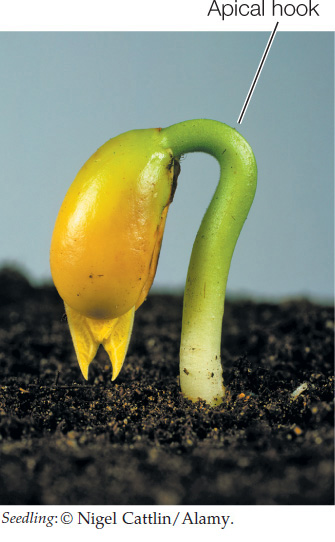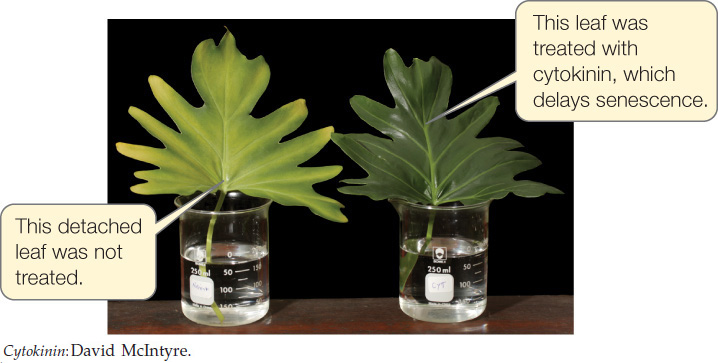CONCEPT26.3 Other Plant Hormones Have Diverse Effects on Plant Development
The discoveries of gibberellins and auxin have led to the isolation of additional classes of plant hormones (see Table 26.2). These hormones have multiple effects, and they interact with one another in many cases.
Ethylene is a gaseous hormone that promotes senescence
Whereas the cytokinins (see below) delay senescence (aging), another plant hormone promotes it: the gas ethylene (see Table 26.2), which is sometimes called the senescence hormone. When streets were lit by gas rather than by electricity, leaves on trees near street lamps dropped earlier in the fall than those on trees farther from the lamps. We now know why: ethylene, a combustion product of the illuminating gas, caused the early abscission. Whereas auxin inhibits leaf abscission, ethylene strongly promotes it; thus the ratio of auxin and ethylene controls abscission.
Fruit Ripening
By promoting senescence, ethylene speeds the ripening of fruit. As a fruit ripens, it loses chlorophyll and its cell walls break down, making the fruit softer; ethylene promotes both of these processes. Ethylene also causes an increase in its own production. Thus once ripening begins, more and more ethylene forms, and because it is a gas, it diffuses readily throughout the fruit and even to neighboring fruits on the same or other plants. The old saying that “one rotten apple spoils the barrel” is true. That rotten apple is a rich source of ethylene, which speeds the ripening and subsequent rotting of the other fruit in a barrel or other confined space.
LINK
The action of ethylene in fruit ripening is an example of positive feedback; see Figure 1.8
Farmers in ancient times poked holes in developing figs to make them ripen faster. Wounding causes an increase in ethylene production by the fruit, and that increase promotes ripening. Today commercial shippers and storers of fruit hasten ripening by adding ethylene to storage chambers. This use of ethylene is the single most important use of a natural plant hormone in agriculture and commerce. Conversely, ripening can be delayed by the use of “scrubbers” and adsorbents (binding substances) that remove ethylene from the atmosphere in fruit storage chambers.

As flowers senesce, their petals may abscise (fall off). Flower growers and florists often immerse the cut stems of ethylene-sensitive flowers in dilute solutions of silver thiosulfate before selling them. Silver salts inhibit ethylene action by interacting directly with the ethylene receptor—thus they delay senescence, keeping flowers “fresh” for a longer time.
Stem Growth
The stems of many eudicot seedlings (which lack protective coleoptiles) form an apical hook that protects the delicate shoot apex while the stem grows through the soil.

The apical hook is maintained through an asymmetrical production of ethylene, which inhibits the expansion of cells on the inner surface of the hook. Once the seedling breaks through the soil surface and is exposed to light, ethylene synthesis stops, and the cells of the inner surface are no longer inhibited. Those cells now expand, and the hook unfolds, raising the shoot apex and the expanding leaves into the sun. Ethylene also inhibits stem elongation in general, promotes lateral swelling of stems (as do the cytokinins), and decreases the sensitivity of stems to gravitropic stimulation. The short, thick, and exaggerated apical hook constitutes the “triple response,” a well-characterized stunted growth habit observed when plants are treated with ethylene.
566
Cytokinins are active from seed to senescence
Like bacteria and yeasts, some plant cells, such as parenchyma cells, can be grown in a liquid or solidified medium containing sugars and salts. For continuous cell division, cultured plant cells also require a type of hormone called a cytokinin, first isolated from corn. More than 150 different cytokinins have been isolated, and most are derivatives of adenine.
Cytokinins have a number of different effects (see Table 26.2), in many cases by interacting with auxin:
- Adding an appropriate combination of auxin and cytokinins to a growth medium induces rapid proliferation of cultured plant cells.
- In cell cultures, a high cytokinin-to-auxin ratio (i.e., a medium containing more cytokinin than auxin) promotes the formation of shoots; a low ratio promotes the formation of roots.
- Cytokinins can cause certain light-requiring seeds to germinate even when they are kept in constant darkness.
- Cytokinins usually inhibit the elongation of stems, but they cause lateral swelling of stems and roots (the fleshy roots of radishes are an extreme example).
- Cytokinins stimulate axillary buds to grow into branches. The auxin-to-cytokinin ratio controls the extent of branching (bushiness) of a plant; a high ratio inhibits branching, a low ratio stimulates it.
- Cytokinins delay the senescence of leaves. If leaf blades are detached from a plant and floated on water or a nutrient solution, they gradually turn yellow and show other signs of senescence. If instead they are floated on a solution containing a cytokinin, they remain green and senesce much more slowly. Roots contain abundant cytokinins, and cytokinin transport to the leaves delays senescence:

Cytokinin appears to act through a pathway that includes proteins similar to those in two-component systems, a type of signal transduction pathway commonly found in bacteria. Indeed, this pathway was one of the first of its kind discovered in eukaryotes. The two components in such a system are:
- a receptor that can act as a protein kinase, phosphorylating itself as well as a target protein
- a target protein, generally a transcription factor, that regulates the response
Genetic screens in Arabidopsis for abnormalities in the response to cytokinin have identified the receptor (AHK; Arabidopsis histidine kinase) and the target protein (ARR; Arabidopsis response regulator). The target protein acts as a transcription factor when phosphorylated. The cytokinin signal transduction pathway also includes a third protein (AHP; Arabidopsis histidine phosphotransfer protein), which transfers phosphates from the receptor to the target protein (FIGURE 26.9). The plant genome has more than 20 genes that are expressed in response to this signaling pathway.

Brassinosteroids are plant steroid hormones
In animals, steroid hormones such as cortisol and estrogen, which are formed from cholesterol, have been well studied for decades (see Chapter 35). In the 1970s, biologists isolated a steroid from the pollen of rape (Brassica napus; sometimes called canola), a member of the mustard family. When applied to various plant tissues, this hormone stimulated cell expansion, pollen tube elongation, and vascular tissue differentiation, but it inhibited root expansion. Mutant plants with defects in brassinosteroid responses are stunted:

Dozens of chemically related, growth-affecting brassino-steroids have been found in plants. Like other plant hormones, brassinosteroids have diverse effects (see Table 26.2):
- They enhance cell expansion and cell division in shoots.
- They promote xylem differentiation.
- They promote growth of pollen tubes during reproduction.
- They promote seed germination.
- They promote apical dominance and leaf senescence.
The signaling pathway for these plant steroids differs sharply from those for steroid hormones in animals. In animals, steroids diffuse through the cell membrane and bind to receptors in the cytoplasm. In contrast, the receptor for brassinosteroids is an integral protein in the cell membrane.
Abscisic acid acts by inhibiting development
The hormone abscisic acid is found in most plant tissues. Many of its actions involve inhibition of other hormones’ actions in the plant (see Table 26.2):
- Prevention of seed germination. Abscisic acid prevents seeds from germinating on the parent plant before the seeds are dry. Premature germination, termed vivipary, is undesirable in cereal crops because the grain is ruined for human consumption if it has started to sprout. Viviparous seedlings are unlikely to survive if they remain attached to the parent plant and are unable to establish themselves in the soil.
- Promotion of seed dormancy. Abscisic acid promotes seed dormancy and inhibits the initiation of germination events, such as the hydrolysis of stored macromolecules, by gibberellins.
- Reaction to stress. Abscisic acid is a “stress hormone” that mediates a number of plant responses to pathogens and environmental stresses. We will describe some of these effects in Chapter 28. For now, consider that when the air is dry, abscisic acid stimulates the closure of stomata to prevent water loss by transpiration (see Concept 25.3).
Abscisic acid provides examples of the complex interactions between plant hormones. Whereas abscisic acid promotes seed dormancy, gibberellic acid inhibits it; whereas abscisic acid inhibits seed germination, both gibberellic acid and ethylene promote it. How the signaling pathways used by these hormones interact is under intense study by plant molecular biologists.
CHECKpointCONCEPT26.3
- Which plant hormones affect cell expansion, and what is the effect in each case?
- At the grocery store, you can buy plastic bags that keep fruit fresh for a much longer period than other containers. How do you think they work?
- A mutant strain of corn shows vivipary. Why is this a disadvantage for the plant and the crop, and what gene might be involved?
As we have seen, plant development is strongly influenced by the environment. For example, in Concept 26.1 we alluded to the role of photoreceptors whose responses to light guide the early growth of seedlings. We will now turn to the molecular nature of these and other plant photoreceptors.